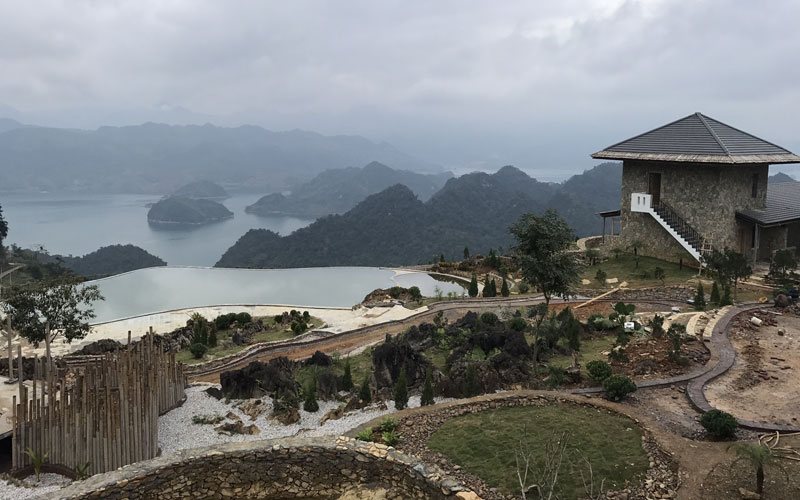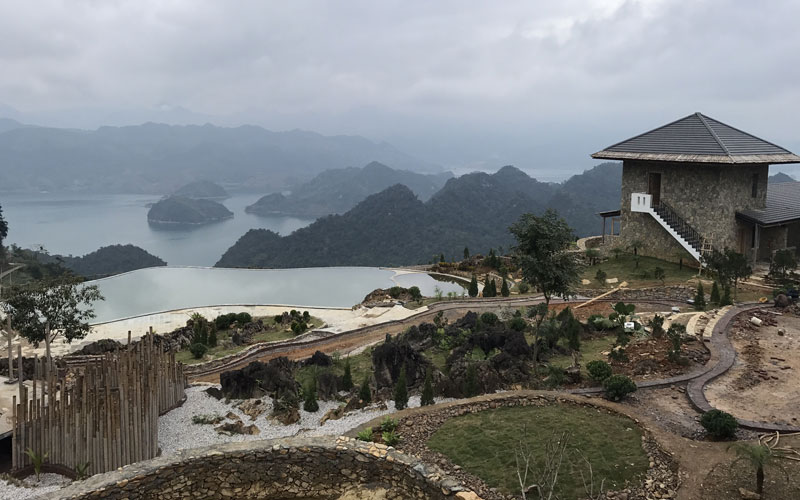


Tourists are experiencing the service at Ba Khan village
resort, Khan Ha hamlet, Ba Khan commune (Mai Chau).
Mr. Bui Van Dong, the Chairman of the People's Committee of Ba Khan commune says: The Party Committee and the commune’s authorities have realized the advantages on the natural landscapes and culture to develop tourism in the commune since 2010. Therefore, the commune has identified tourism as an important economic sector to develop. A lot of tourists have been coming to Ba Khan to experience the meandering and bending roads and to explore the indigenous culture but they don't reside temporarily.
The reason is that Ba Khan has not built an accommodation for tourists yet. Facing this reality, the commune has advised the People's Committee of the district to develop a plan to attract investment for tourism development. The mechanisms and policies to create favorable conditions for investors to build resorts have been set up. Additionally, the promotion of the romantic images of Ba Khan has been strengthened on the mass media.
In 2017, Ba Khan Tourist joint Stock Company invested in constructing a project of Ba Khan village resort in Khan Ha hamlet with a total investment of over 13 billion dongs. This is an important breakthrough marking the tourism development of the poor Ba Khan commune. As a result, Ba Khan has promoted investment in transport infrastructure, preserving the natural landscapes and the cultural identity of the Muong and Thai ethnic people, ensuring the good environmental sanitation and maintaining the order and security. Currently, there are 2 private enterprises investing in ecotourism in Ba Khan commune. One project is carrying out the clearance and the construction procedures and the other is under the construction as well as welcomes guests to stay and relax.
Mr. Nguyen Van Hai, the Director of Ba khan Village Tourism joint Stock Company says: Ba Khan Village Resort has a total area of 5,000 m2, which has been built in the combination of the contemporary and traditional architectures. The terrain, the natural landscapes, the vegetational cover have been kept in the original state. In addition, we also use materials such as bamboo to make the ceiling and furniture to create a sense of being friendly to the nature. We are interested in giving travelers experiencing activities like walking, cycling, and climbing. The resort is expected to be completed in early November, creating jobs for more than 20 local laborers in Ba Khan commune.
Besides developing eco-tourism in combination with community tourism, Ba Khan commune has also been exploiting the potential of spiritual tourism. Hai Quan Temple in Khan Thuong hamlet is a sacred temple worshiped and preserved by people in the commune and the surrounding areas. Every year, on January 7 of the lunar calendar, people in the commune are eager to go to the spring festival of Hai Quan temple. The festival of Hai Quan temple attracts thousands of people.
Mr. Bui Van Dong, the Chairman of the People's Committee adds that one of the advantages to bring Ba Khan tourism on the momentum of development is that the commune is in the planning of the national tourist area of Hoa Binh lake. This is an opportunity for Ba Khan to link with many other localities to build tours on Hoa Binh lake. In the coming time, the Party Committee and the communal authorities will enhance promoting the images of nature, culture and people of Ba Khan in order to attract investors. Training the human resources for tourism to meet the requirements of quantity and quality, supporting and helping people develop specific tourism products have been strengthened.